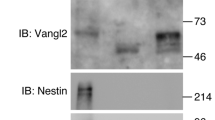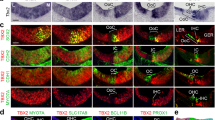Abstract
The mammalian auditory sensory organ, the organ of Corti, consists of sensory hair cells with uniformly oriented stereocilia on the apical surfaces and has a distinct planar cell polarity (PCP) parallel to the sensory epithelium1,2,3. It is not certain how this polarity is achieved during differentiation4,5. Here we show that the organ of Corti is formed from a thicker and shorter postmitotic primordium through unidirectional extension, characteristic of cellular intercalation known as convergent extension6. Mutations in the PCP pathway interfere with this extension, resulting a shorter and wider cochlea as well as misorientation of stereocilia. Furthermore, parallel to the homologous pathway in Drosophila melanogaster7,8, a mammalian PCP component Dishevelled2 shows PCP-dependent polarized subcellular localization across the organ of Corti. Taken together, these data suggest that there is a conserved molecular mechanism for PCP pathways in invertebrates and vertebrates and indicate that the mammalian PCP pathway might directly couple cellular intercalations to PCP establishment in the cochlea.
This is a preview of subscription content, access via your institution
Access options
Subscribe to this journal
Receive 12 print issues and online access
$209.00 per year
only $17.42 per issue
Buy this article
- Purchase on Springer Link
- Instant access to full article PDF
Prices may be subject to local taxes which are calculated during checkout






Similar content being viewed by others

References
Montcouquiol, M. et al. Identification of Vangl2 and Scrb1 as planar polarity genes in mammals. Nature 423, 173–177 (2003).
Curtin, J.A. et al. Mutation of Celsr1 disrupts planar polarity of inner ear hair cells and causes severe neural tube defects in the mouse. Curr. Biol. 13, 1129–1133 (2003).
Lu, X. et al. PTK7/CCK-4 is a novel regulator of planar cell polarity in vertebrates. Nature 430, 93–98 (2004).
Chen, P., Johnson, J.E., Zoghbi, H.Y. & Segil, N. The role of Math1 in inner ear development: Uncoupling the establishment of the sensory primordium from hair cell fate determination. Development 129, 2495–2505 (2002).
Lewis, J. & Davies, A. Planar cell polarity in the inner ear: how do hair cells acquire their oriented structure? J. Neurobiol. 53, 190–201 (2002).
Keller, R. Shaping the vertebrate body plan by polarized embryonic cell movements. Science 298, 1950–1954 (2002).
Axelrod, J.D. Unipolar membrane association of Dishevelled mediates Frizzled planar cell polarity signaling. Genes Dev. 15, 1182–1187 (2001).
Bastock, R., Strutt, H. & Strutt, D. Strabismus is asymmetrically localized and binds to Prickle and Dishevelled during Drosophila planar polarity patterning. Development 130, 3007–3014 (2003).
Ruben, R.J. Development of the inner ear of the mouse: a radioautographic study of terminal mitoses. Acta Otolaryngol. (Stockh.) Supp. 220, 1–44 (1967).
Chen, P. & Segil, N. p27(Kip1) links cell proliferation to morphogenesis in the developing organ of Corti. Development 126, 1581–1590 (1999).
McKenzie, E., Krupin, A. & Kelley, M.W. Cellular growth and rearrangement during the development of the mammalian organ of Corti. Dev. Dyn. 229, 802–812 (2004).
Vinson, C.R. & Adler, P.N. Directional non-cell autonomy and the transmission of polarity information by the frizzled gene of Drosophila. Nature 329, 549–551 (1987).
Mlodzik, M. Planar cell polarization: do the same mechanisms regulate Drosophila tissue polarity and vertebrate gastrulation? Trends Genet. 18, 564–571 (2002).
Ma, D., Yang, C.H., McNeill, H., Simon, M.A. & Axelrod, J.D. Fidelity in planar cell polarity signalling. Nature 421, 543–547 (2003).
Tree, D.R., Ma, D. & Axelrod, J.D. A three-tiered mechanism for regulation of planar cell polarity. Semin. Cell Dev. Biol. 13, 217–224 (2002).
Kibar, Z. et al. Ltap, a mammalian homolog of Drosophila Strabismus/Van Gogh, is altered in the mouse neural tube mutant Loop-tail. Nat. Genet. 28, 251–255 (2001).
Chae, J. et al. The Drosophila tissue polarity gene starry night encodes a member of the protocadherin family. Development 126, 5421–5429 (1999).
Usui, T. et al. Flamingo, a seven-pass transmembrane cadherin, regulates planar cell polarity under the control of Frizzled. Cell 98, 585–595 (1999).
Lijam, N. et al. Social interaction and sensorimotor gating abnormalities in mice lacking Dvl1. Cell 90, 895–905 (1997).
Hamblet, N.S. et al. Dishevelled 2 is essential for cardiac outflow tract development, somite segmentation and neural tube closure. Development 129, 5827–5838 (2002).
Darken, R.S. et al. The planar polarity gene strabismus regulates convergent extension movements in Xenopus. EMBO J. 21, 976–985 (2002).
Goto, T. & Keller, R. The planar cell polarity gene strabismus regulates convergence and extension and neural fold closure in Xenopus. Dev. Biol. 247, 165–181 (2002).
Wallingford, J.B. et al. Dishevelled controls cell polarity during Xenopus gastrulation. Nature 405, 81–85 (2000).
Wallingford, J.B. & Harland, R.M. Neural tube closure requires Dishevelled-dependent convergent extension of the midline. Development 129, 5815–5825 (2002).
Axelrod, J.D., Miller, J.R., Shulman, J.M., Moon, R.T. & Perrimon, N. Differential recruitment of dishevelled provides signaling specificity in the planar cell polarity and wingless signaling pathways. Genes Dev. 12, 2610–2622 (1998).
Boutros, M., Paricio, N., Strutt, D.I. & Mlodzik, M. Dishevelled activates JNK and discriminates between JNK pathways in planar polarity and wingless signaling. Cell 94, 109–118 (1998).
Torban, E., Wang, H.J., Groulx, N. & Gros, P. Independent mutations in mouse Vangl2 that cause neural tube defects in looptail mice impair interaction with members of the Dishevelled family. J. Biol. Chem. 279, 52703–52713 (2004).
Kelley, M.W., Xu, X.M., Wagner, M.A., Warchol, M.E. & Corwin, J.T. The developing organ of Corti contains retinoic acid and forms supernumerary hair cells in response to exogenous retinoic acid in culture. Development 119, 1041–1053 (1993).
Jiang, D., Munro, E.M. & Smith, W.C. Ascidian prickle regulates both mediolateral and anterior-posterior cell polarity of notochord cells. Curr. Biol. 15, 79–85 (2005).
Radde-Gallwitz, K. et al. Expression of Islet 1 marks the sensory and neuronal lineages in the mammalian inner ear. J. Comp. Neurol. 477, 412–421 (2004).
Acknowledgements
We thank K. Moses, W. Sale, B. Shur and J. Wallingford for discussions during the project and comments on the manuscript; D. Martin, T. Etzel, E. Kothari and J. Zhao for transgenic service; D. Wu for technical advice on inner ear paint fill; R. Apkarian for SEM; J. Saek for hair cell counting; J.E. Johnson for Math1GFP animals; W. Sale for acetylated α-tubulin antibody; the UCSD/NINDS Neuroscience Microscopy Core; and the Developmental Studies Hybridoma Bank for Islet1 antibody. This work is supported by grants from the US National Institute of Health (to A.C., X.L., A.W.-B. and P.C.), the Woodruff Foundation (to X.L. and P.C.) and the American Heart Association (to J.W.).
Author information
Authors and Affiliations
Corresponding authors
Ethics declarations
Competing interests
The authors declare no competing financial interests.
Supplementary information
Supplementary Fig. 1
Unidirectional extension of the cochlea and its sensory organ by DiI labeling in vitro. (PDF 65 kb)
Supplementary Fig. 2
Generation of transgenic mice carrying Dvl2-EGFP. (PDF 315 kb)
Supplementary Fig. 3
Postulated radial and medial-lateral intercalation of the organ of Corti during terminal differentiation. (PDF 109 kb)
Supplementary Table 1
Tabulation of decreased length to width ration and hair cell numbers in PCP mutants. (PDF 100 kb)
Supplementary Table 2
Primers used for genotyping and cDNA amplification. (PDF 32 kb)
Rights and permissions
About this article
Cite this article
Wang, J., Mark, S., Zhang, X. et al. Regulation of polarized extension and planar cell polarity in the cochlea by the vertebrate PCP pathway. Nat Genet 37, 980–985 (2005). https://doi.org/10.1038/ng1622
Received:
Accepted:
Published:
Issue Date:
DOI: https://doi.org/10.1038/ng1622
This article is cited by
-
Functional interaction between Vangl2 and N-cadherin regulates planar cell polarization of the developing neural tube and cochlear sensory epithelium
Scientific Reports (2023)
-
USP39 is essential for mammalian epithelial morphogenesis through upregulation of planar cell polarity components
Communications Biology (2022)
-
EMX2-GPR156-Gαi reverses hair cell orientation in mechanosensory epithelia
Nature Communications (2021)
-
Mechanical forces drive ordered patterning of hair cells in the mammalian inner ear
Nature Communications (2020)
-
PCP and Wnt pathway components act in parallel during zebrafish mechanosensory hair cell orientation
Nature Communications (2019)


